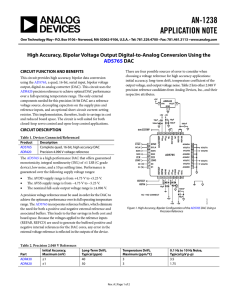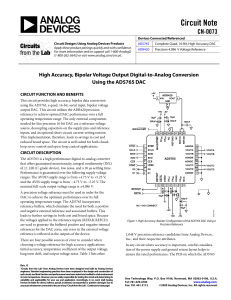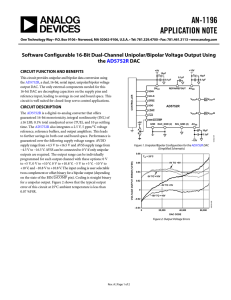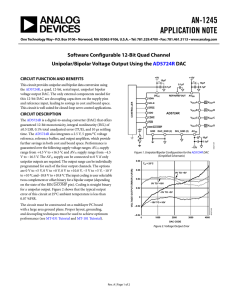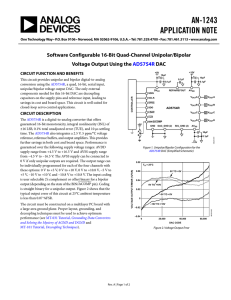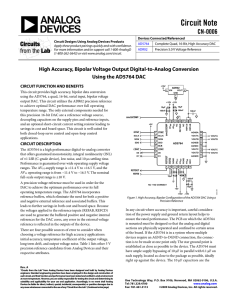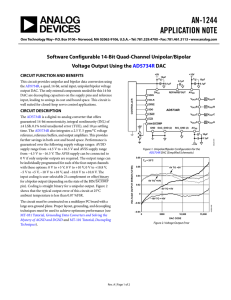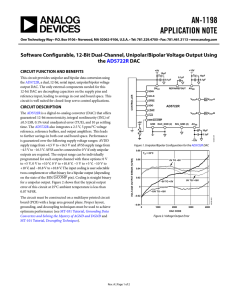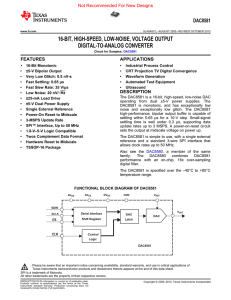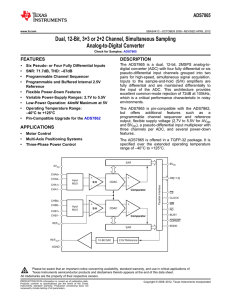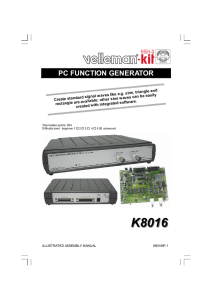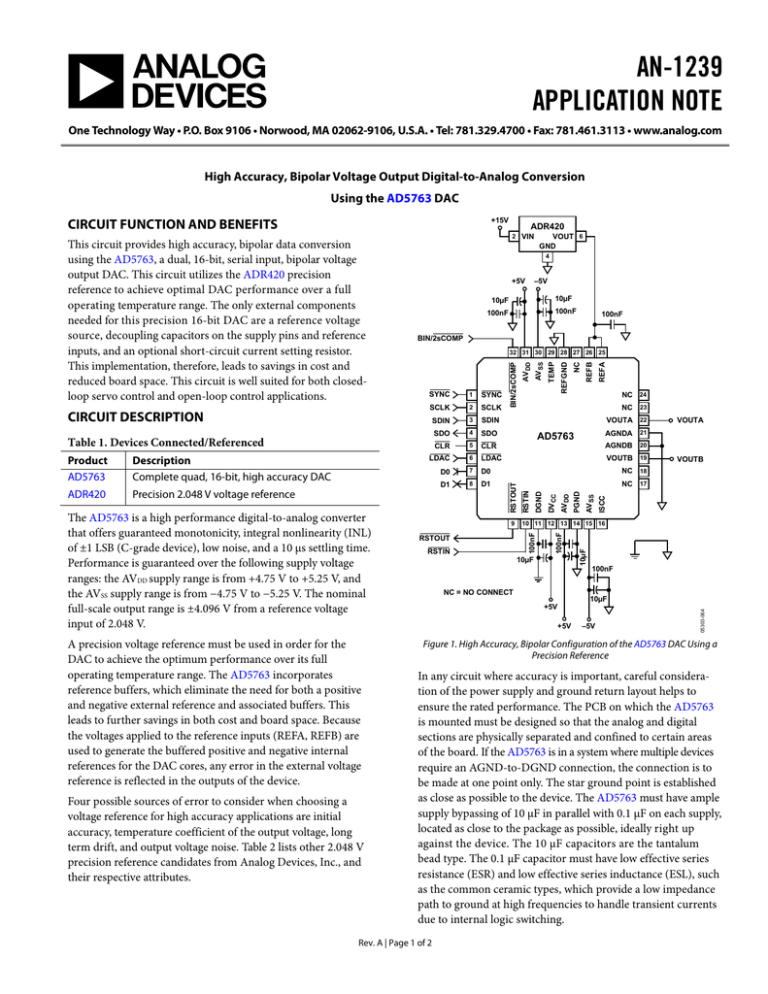
AN-1239
APPLICATION NOTE
One Technology Way • P.O. Box 9106 • Norwood, MA 02062-9106, U.S.A. • Tel: 781.329.4700 • Fax: 781.461.3113 • www.analog.com
High Accuracy, Bipolar Voltage Output Digital-to-Analog Conversion
Using the AD5763 DAC
CIRCUIT FUNCTION AND BENEFITS
+15V
4
+5V
SYNC
2
SCLK
SDIN
3
SDIN
SDO
4
SDO
A precision voltage reference must be used in order for the
DAC to achieve the optimum performance over its full
operating temperature range. The AD5763 incorporates
reference buffers, which eliminate the need for both a positive
and negative external reference and associated buffers. This
leads to further savings in both cost and board space. Because
the voltages applied to the reference inputs (REFA, REFB) are
used to generate the buffered positive and negative internal
references for the DAC cores, any error in the external voltage
reference is reflected in the outputs of the device.
Four possible sources of error to consider when choosing a
voltage reference for high accuracy applications are initial
accuracy, temperature coefficient of the output voltage, long
term drift, and output voltage noise. Table 2 lists other 2.048 V
precision reference candidates from Analog Devices, Inc., and
their respective attributes.
REFA
NC
REFB
AVSS
TEMP
AVDD
REFGND
1
SCLK
BIN/2sCOMP
SYNC
NC 24
NC 23
VOUTA 22
CLR
5
CLR
AGNDB 20
LDAC
6
LDAC
VOUTB 19
D0
7
D0
NC 18
D1
8
D1
NC 17
10µF
ISCC
AVSS
VOUTB
10µF
RSTIN
PGND
10 11 12 13 14 15 16
AVDD
9
RSTOUT
VOUTA
AGNDA 21
AD5763
100nF
100nF
NC = NO CONNECT
10µF
+5V
+5V
–5V
05303-064
The AD5763 is a high performance digital-to-analog converter
that offers guaranteed monotonicity, integral nonlinearity (INL)
of ±1 LSB (C-grade device), low noise, and a 10 μs settling time.
Performance is guaranteed over the following supply voltage
ranges: the AVDD supply range is from +4.75 V to +5.25 V, and
the AVSS supply range is from −4.75 V to −5.25 V. The nominal
full-scale output range is ±4.096 V from a reference voltage
input of 2.048 V.
100nF
32 31 30 29 28 27 26 25
DVCC
Precision 2.048 V voltage reference
100nF
DGND
ADR420
10µF
100nF
Description
Complete quad, 16-bit, high accuracy DAC
10µF
100nF
BIN/2sCOMP
Table 1. Devices Connected/Referenced
Product
AD5763
–5V
RSTIN
CIRCUIT DESCRIPTION
VOUT 6
GND
RSTOUT
This circuit provides high accuracy, bipolar data conversion
using the AD5763, a dual, 16-bit, serial input, bipolar voltage
output DAC. This circuit utilizes the ADR420 precision
reference to achieve optimal DAC performance over a full
operating temperature range. The only external components
needed for this precision 16-bit DAC are a reference voltage
source, decoupling capacitors on the supply pins and reference
inputs, and an optional short-circuit current setting resistor.
This implementation, therefore, leads to savings in cost and
reduced board space. This circuit is well suited for both closedloop servo control and open-loop control applications.
ADR420
2 VIN
Figure 1. High Accuracy, Bipolar Configuration of the AD5763 DAC Using a
Precision Reference
In any circuit where accuracy is important, careful consideration of the power supply and ground return layout helps to
ensure the rated performance. The PCB on which the AD5763
is mounted must be designed so that the analog and digital
sections are physically separated and confined to certain areas
of the board. If the AD5763 is in a system where multiple devices
require an AGND-to-DGND connection, the connection is to
be made at one point only. The star ground point is established
as close as possible to the device. The AD5763 must have ample
supply bypassing of 10 μF in parallel with 0.1 µF on each supply,
located as close to the package as possible, ideally right up
against the device. The 10 μF capacitors are the tantalum
bead type. The 0.1 µF capacitor must have low effective series
resistance (ESR) and low effective series inductance (ESL), such
as the common ceramic types, which provide a low impedance
path to ground at high frequencies to handle transient currents
due to internal logic switching.
Rev. A | Page 1 of 2
AN-1239
Application Note
Table 2. Precision 2.048 V References
Part Number
ADR430
ADR420
Initial Accuracy Max
(mV)
±1
±1
Long-Term Drift Typ
(ppm)
40
50
The power supply traces of the AD5763 must be as wide as
possible to provide low impedance paths and reduce the effects
of glitches on the power supply line. Fast switching signals, such
as clocks, must be shielded with digital ground to avoid
radiating noise to other parts of the board and must never be
run near the reference inputs. A ground line routed between the
SDIN and SCLK lines helps reduce crosstalk between them (not
required on a multilayer board, which has a separate ground
plane; however, it is helpful to separate the lines). It is essential
to minimize noise on the reference inputs because it couples
through to the DAC output. Avoid crossover of digital and
analog signals. Traces on opposite sides of the board must run
at right angles to each other. This reduces the effects of
feedthrough on the board. A microstrip technique is
recommended but not always possible with a double-sided
board. In this technique, the component side of the board is
dedicated to the ground plane, and signal traces are placed on
the solder side. Best layout and performance are achieved with
at least a 4-layer multilayer board, where there are a ground
plane layer, a power supply layer, and two signal layers.
Temp Drift Max
(ppm/°C)
3
3
0.1 Hz to 10 Hz Noise
Typ (μV p-p)
3.5
1.75
LEARN MORE
Kester, Walt. 2005. The Data Conversion Handbook. Analog
Devices. Chapters 3 and 7.
MT-015 Tutorial, Basic DAC Architectures II: Binary DACs.
Analog Devices.
MT-031 Tutorial, Grounding Data Converters and Solving the
Mystery of AGND and DGND. Analog Devices.
MT-101 Tutorial, Decoupling Techniques. Analog Devices.
Voltage Reference Wizard Design Tool.
Data Sheets and Evaluation Boards
AD5763 Data Sheet.
AD5765 Evaluation Board (Compatible with AD5763).
ADR420 Data Sheet.
REVISION HISTORY
4/13—Rev. 0 to Rev. A
Document Title Changed from CN-0074 to
AN-1239 .............................................................................. Universal
6/09—Revision 0: Initial Version
©2009–2013 Analog Devices, Inc. All rights reserved. Trademarks and
registered trademarks are the property of their respective owners.
AN08274-0-4/13(A)
Rev. A | Page 2 of 2

